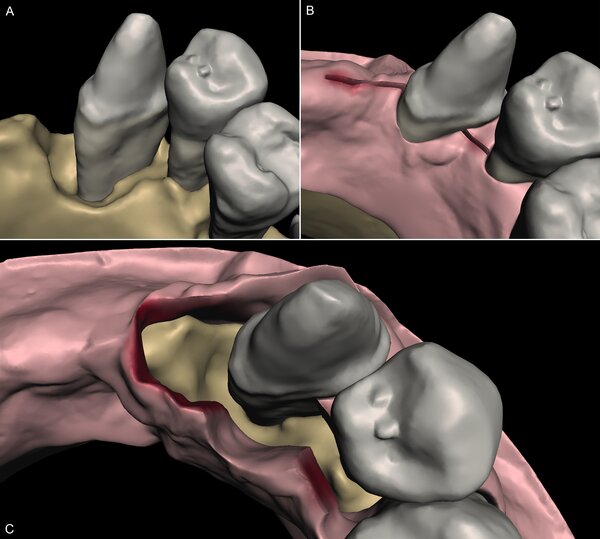New digital tools are aiding the periodontist's work and potentially revolutionising dentistry, enhancing the predictability of treatments and improving patient outcomes. Dániel Palkovics, one of the three winners of the EFP’s Digital Innovation Award 2024, outlines the potential of the "3D Periodontist".
Digitalization is constantly revolutionizing dentistry to enhance the precision and predictability of treatments and to improve patient outcomes. Virtual treatment planning, guided surgical procedures, and digital solutions are slowly becoming the standard of care in many fields of dentistry, including implantology, orthodontics, and maxillofacial surgery.
Although options such as guided aesthetic crown lengthening do exist, there are no digital solutions and tools available for the comprehensive planning and treatment of stage III and stage IV periodontitis. Moreover, the “gold standard” diagnostic methods (i.e., clinical periodontal probing, intraoral radiographs) are limited in their ability to accurately assess and visualize the periodontal status of patients.
The aim of the 3D Periodontist innovation is to close the gap by providing a digital treatment planning software for comprehensive periodontal rehabilitation and thereby improve patient outcomes.

The 3D Periodontist innovation will support periodontal treatment planning through:
- 3D periodontal charts.
- Automated single-tooth prognosis.
- Virtual planning of regenerative surgeries.
- Assessment of attachment level changes in 3D.
This innovation uses a “virtual periodontal patient” (VPP) model, in which clinical periodontal parameters are overlaid onto the patient’s “digital twin”, a 3D model generated from processed cone-beam computed tomography (CBCT) images and intraoral scans (IOS). Achieved with the help of a deep-learning-based image-processing method, the model depicts the 3D topography of periodontal bone and soft-tissue conditions.
After recording a full periodontal chart, probing pocket depth (PPD) and gingival recession values are displayed around the digital model of the teeth. The VPP model thus enables users to assess the correlation between PPD values and radiographic bone levels. The tool helps clinicians choose the most suitable incision line, flap design, and regenerative strategy for each case by providing detailed 3D visualizations and by integrating clinical data.


The VPP model assists clinicians in making informed decisions for tooth prognosis. The software will automatically determine the prognosis of teeth according to clinical probing measurements and the percentage of radiographic bone loss.
By providing a 3D image of the periodontal tissues, 3D Periodontist will not only help in selecting the optimal regenerative strategy but will also identify the surgical incision line and the surgical flap design based on the most convenient access to the intrabony component of the defect.

The 3D Periodontist enables users to compare patient data from different time points to evaluate the efficacy of the periodontal treatment. Clinicians can track these changes over time and gain valuable insights into the changes in the patient’s condition. This 3D analysis provides a comprehensive understanding of hard- and soft-tissue changes and alterations in clinical periodontal parameters.
With conventional diagnostic modalities it is often challenging to fully comprehend the topography of the periodontal hard and soft tissue. 3D Periodontist not only visualizes teeth with surrounding hard and soft tissues in 3D but can also superimpose clinical periodontal parameters over the patient’s digital twin.
While routine diagnostic methods are sufficient in most clinical cases, determining the optimal treatment plan in advanced periodontitis can be challenging. Thus, utilizing a VPP model and more precise 3D planning may enhance treatment success.

Biography
Dániel Palkovics graduated from Semmelweis University (Budapest, Hungary) in 2016. After graduation he started his residency at the university’s Department of Periodontology under the mentorship of Professor István Gera and received his specialization in 2019. He then started his PhD training programme under the supervision of Professor Peter Windisch on The application of digital three-dimensional technologies in reconstructive periodontal surgery and implant dentistry.
His research work focuses mainly on radiographic image processing, artificial intelligence, CAD, and 3D-printing and their clinical use in periodontology and reconstructive surgery.




